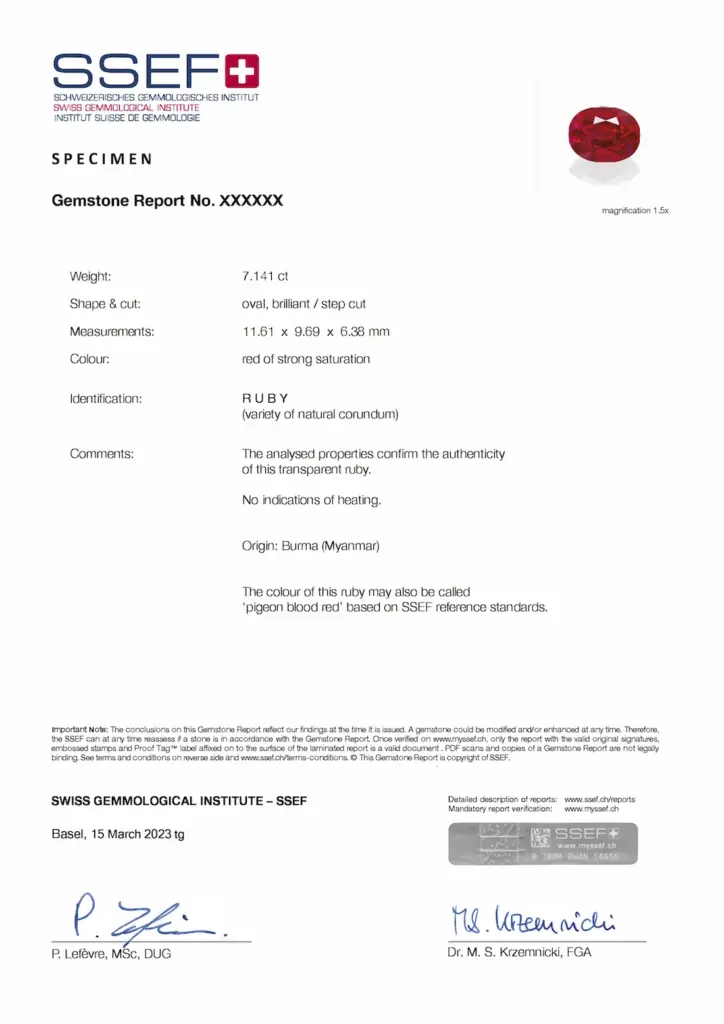Ruby
Ruby is the red variety of corundum that is colored by chromium. Ruby is found in metamorphic (e.g. Burmese marble and Mozambique amphibolite) deposits, or magmatic geological environments. Untreated high-quality ruby is one of the most scarse and expensive gems on the market. Ruby is often treated to enhance its color and/or transparency. Low-quality rough samples may be treated with lead glass, a treatment that has become widespread in the past decade. Ruby mines today are found amongst others in Burma (Myanmar), Mozambique, Vietnam, Afghanistan, Madagascar, Tajikistan, Thailand, Tanzania and Kenya.

Report No & Photo
The SSEF report number is the number given to the item when it is submitted for testing, and is a unique number. If an item is resubmitted later for a ‚recheck‘ after re-cutting or for a report update then the item obtains a new report number.
The photo of a ruby depicts the gem at the time of testing. The photo on an SSEF report is for representational purposes and does not necessarily represent actual colour, clarity or size. For size comparison purposes, approx. magnification used is provided under the photo on the report.
Weight
Weight of a ruby in carats, measured and stated with 3 digits. In the case of mounted jewellery, total weight corresponds to total weight of jewellery item(s) and is stated in grams.
Shape & Cut
The shape and cut describe the outlining shape and cutting style of an examined gemstone. For jewellery items with several stones, a range of shapes and cuts may be stated, if these vary.
Measurements
The measurements are given at 2 decimal places. They generally represent length x width x height of a gemstone. For series of gemstones or gemstones in jewellery, a range of measurements may be stated on the report.
Colour
Colour description on an SSEF report for a ruby describes both the colour hue (e.g. red), potentially a modifier (e.g. pinkish), and the saturation of colour(e.g. red of medium strong saturation). The saturation scale for rubies (example red colour) used by SSEF is:
- red of medium strong saturation
- red of strong saturation
SSEF only uses descriptive terms for sapphires (i.e. colour and saturation). The only trade name that is applied is ‘pigeon blood red’ which can be granted to unmounted rubies of red of strong saturation that match all SSEF criteria. For a detailed description of SSEF’s pigeon blood red criteria see here.
Identification
The identification section of an SSEF report can include the variety name and the mineralogical group name of a gemstone. As such, for rubies:
- Ruby (natural variety of corundum)
A synthetic ruby would be clearly identified and labeled on a report in the identification section.
Treatment
Rubies are quite often treated to improve their appearance. These treatments include fissure filling (e.g. with oil), heating, heating with a flux, heating with lead glass filling, and diffusion treatment. As we follow a full disclosure policy, all these treatments detected at the time of testing, will be described in the comments section of an SSEF report. If no heat treatment has been identified ‘no indications of heating’ is written on the report. If heat treatment has been detected through gemmological analysis, the SSEF report would state ‘indications of heating’.
Residues (e.g. borax glass) are additionally quantified as minor / moderate/ significant residue in healed fissures (and cavities, if present). Fissure filling of rubies (e.g. with oil) would be disclosed as ‘minor / moderate / significant amount of oil in fissures at the time of testing’. For the correspondence between different terminologies, please also refer to LMHC Information Sheets 1, 3 and 5. If an insignificant amount of filler (e.g. oil, artificial resin) is present in a stone, this is not mentioned on an SSEF report. This is in line with international LMHC guidelines.
Origin
Origin determination is an expert opinion. At SSEF origin determination relies on the analysis of microscopic features, trace element concentrations, and spectroscopic data of a coloured gemstone. The measured data pertaining to a specific client stone is then compared with our extensive reference collection and database of coloured gemstones of known origin, and scientific gemmological literature.
Report date & verification
The date corresponds to the date on which gemmological testing of the item was concluded. SSEF reports can be verified on www.myssef.ch